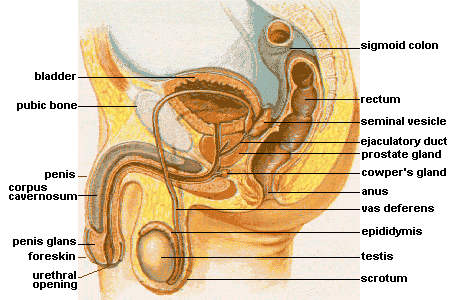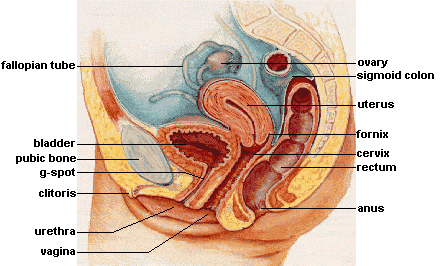Did you know that the biological foundations of sexuality are the same for males and females for the first several weeks of life? It isn’t until about 9–12 weeks after conception that sexual differences between males and females become barely visible.[i] At that point, male and female sexual differentiation unfolds in stages, with much of the female genitalia forming inside the body, and much of the male genitalia forming outside of it. By birth the differences are readily apparent. Although by adulthood males and females look and function differently in many ways, this shared foundation makes it apparent that men and women are both fundamentally equipped to become sexual beings.
MALE ANATOMY
Because male genitalia are more external than female genitalia, males often have a better understanding of their bodies than do women. This understanding can begin in infancy, when boys are able to get a visual (and literal) grasp on their genitals more easily than are females.
In terms of reproduction, grown males have the ability to make several million sperm a day. Those sperm are formed in the testes, mature in the epididymis, and during orgasm are ejaculated through the vas deferens along with fluid from the Cowper’s gland, seminal vesicle, and prostate gland (fluid that helps sperm maximize their potency) out the urethral opening.
DOES SIZE MATTER?
An erection is created by a rush of blood to the penis. That blood fills the chambers of the corpus cavernosum of the penis, which is what gives the penis its rigidity. If a male is circumcised, the foreskin of the penis is surgically removed, typically within a few days of birth. There appears to be no difference in sexual satisfaction or performance between males who are circumcised and those who are not.[ii] In spite of spam emails that often suggest otherwise, the average U.S. male’s erect penis length is 5.5 inches (with most falling between 4.5 and 6.5 inches long) with an average circumference of almost 5 inches.[iii] One study found that just over half of men (55%) were satisfied with their penis size, whereas fully 85% of women were satisfied their partner’s penis size.[iv] Does size matter? It appears that in real terms, the answer is no, but perception of penis size does matter. Penis size is a static (unchangeable by diet, exercise, and magic supplements) and inherited characteristic. Sexual satisfaction is based far more on the perception of penis size and satisfaction with that perception than on penis size itself.[v] The moral of this story: Be happy with what you’ve got!

FEMALE ANATOMY
Female genitalia are not as visible as male genitalia. In terms of reproduction, a female is born with all of her eggs—about 1 to 2 million of them. Women menstruate, or have a 4–5 day period, about every 28 days beginning at puberty, which typically occurs around age 11 in the U.S., lasting until menopause, which usually takes place at about 50 years of age. These guidelines are all big generalizations, so if your experience is slightly different don’t feel concern. You are probably still within a normal range.
A period takes place when an egg travels from the ovaries, through the Fallopian tubes, into the uterus without being fertilized by a male sperm, and so the lining of the uterus, along with the egg (one of the largest cells in the human body, and barely visible to the naked eye), is sloughed off and flushed out of the vaginal canal during a period of bleeding. What is amazing is that a woman’s body is daily changing conditions to be constantly creating an ideal environment for conceiving and carrying a child. Achieving this constant ideal environment requires some very complex systems—hormones, lubrication, daily discharge of any bacteria, ovulation, and renewal through a monthly cycle.
UNCOVERING THE MYSTERY
One difference between males and females is that the female urethra, the place where urine exits the body, is separate from their sexual organs, whereas for men the urethra fills a dual purpose—eliminating urine and carrying seminal fluid. From front to back women have three openings: The urethra, the vagina, and the anus. The vagina opens to the uterus, which is the size of an up-side down pear (where a baby would grow if the egg is fertilized) situated at the top of the vagina. The vulva, or the outer part of the female genitalia, includes the labia majora and minora—or what are sometimes called “lips,” the clitoris, and the vestibule of the vagina.

At the top of the vulva, where the lips come together, sits the clitoris. This tiny organ is somewhat similar to the male penis (remember our shared origins) in that it provides most of the sexual pleasure for an individual. Although there is a high degree of variability between women, the nerves of the clitoris run down into the inner and outer labia, into the perineum (muscle and skin between the vagina and anus), and even into the upper thighs, making touch in those areas highly pleasurable. The clitoris becomes engorged with blood during arousal, similar to the penis. The clitoris is unique in that its only function is sexual pleasure—in that regard, women possess something that men do not.[vi] For most women, orgasm is linked to clitoral stimulation. The vagina has far fewer nerve endings than the male penis or the female clitoris. Although penis-in-vagina sex can feel pleasurable to a woman, it is often not enough stimulation to bring her to orgasm–again, the path to orgasm for most women is through clitoral stimulation.[vii] Understanding a woman’s anatomy is important for both men and women to ensure a positive sexual experience. When women orgasm, they have the sensation of rhythmic pulses in the vagina and uterus, quite similar to male rhythmic pulses that accompany ejaculation and orgasm. Because women don’t usually have the same understanding of their genitals as men do, you can learn even more about female sexual response here.
TOGETHER, APART, AND TOGETHER AGAIN
Our bodies are truly amazing. We start from a shared physical foundation, and then we develop into unique male and female sexual beings. We then learn how to share emotions and meaning with our partner. We learn how we each are sexually unique but together create true intimacy. Learning more about your own sexual anatomy can lead to discovery, acceptance of your body, and greater appreciation for your sexuality. Learning about your anatomy and your spouse’s anatomy can be an important part of the journey toward healthy sexuality.
[i] Ray, R., Josso, N., & Racine, C. (2020). Sexual differentiation. National Center for Biotechnology Information, U.S. National Library of Medicine. https://www.ncbi.nlm.nih.gov/books/NBK279001/
[ii] https://www.healthline.com/health/mens-health/circumcised-vs-uncircumcised#sexual-sensitivity
[iii] Herbenick, D., Reece, M., Schick, V., & Sanders, S. A. (2014). Erect penile length and circumference dimensions of 1,661 sexually active men in the United States. Journal of Sexual Medicine, 11(1), 93–101.
[iv] Lever, J., Frederick, D. A., & Peplau, L. A. (2006). Does size matter? Men’s and women’s views on penis size across the lifespan. Psychology of Men & Masculinity, 7(3), 129–143.
[v] Johnston, L., McLellan, T., & McKinlay, A. (2014). (Perceived) size really does matter: Male dissatisfaction with penis size. Psychology of Men & Masculinity, 15(2), 225–228.
[vi] Mintz, L. (2017). Becoming cliterate: Why orgasm equality matters and how to get it. New York: HarperCollins.
[vii] Busby, D. M., Carroll, J. S., & Leavitt, C. E. (2013). Sexual wholeness in marriage: An LDS perspective on integrating sexuality and spirituality in our marriages.

Rebecca Clarke
Rebecca W. Clarke is a PhD student at Brigham Young University studying with Dr. Chelom Leavitt. Her research focus is religion and sexuality, and she is currently working on papers dealing with sexual sanctification, sexual flourishing, and religiosity. Rebecca has been married to Sam Clarke for 24 years and they have four children.

